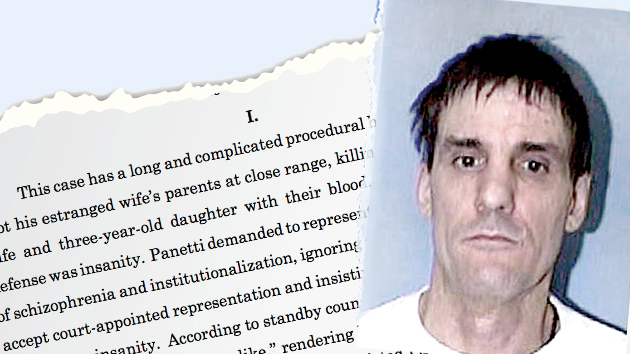
Scott PanettiTexas Department of Criminal Justice via AP
Update 12/1/2014: Texas courts have rejected all of Panetti’s appeals, despite vigorous dissents by conservative Republican judges, including one who came out in favor of abolishing the death penalty altogether. Today, Panetti’s lawyers asked the US Supreme court to stop his execution on the grounds that his execution would be unconstitutional because executing a severely mentally ill person violates the Eighth Amendment’s ban on cruel and unusual punishment. They argue that executing Panetti would violate an emerging public consensus in which most Americans oppose executing people with major mental illness. Panetti’s clemency petition is still pending before the Texas Board of Pardons and Parole, and is supported by a bipartisan coalition that includes dozens of evangelical leaders as well as Texas politicians—including former US representative Ron Paul.
Update 10/30/14: Texas has scheduled Panetti’s execution for December 3.
six years before he murdered his in-laws in Texas, Scott Panetti piled household furniture and valuables in his yard, sprayed them down with water, and buried some of them. The devil, he claimed, was in it. After he was arrested and charged with the killings, Panetti, who has a history of severe mental illness, represented himself at his capital trial wearing a purple cowboy suit. He called himself “Sarge” and subpoenaed Jesus, among other notables. He lost, of course. The jury found him guilty and sentenced him to death.
The case made its way though the appeals courts, eventually reaching the United States Supreme Court, which in 2007 ruled that the state of Texas hadn’t adequately evaluated whether Panetti’s mental condition allowed him to fully understand the nature of his punishment—a constitutional prerequisite for the death penalty. The court stayed the execution and sent the case back for further proceedings.
Seven years later, Panetti’s illness hasn’t gone away, but the Supreme Court has given Texas the green light to kill him. The court’s decision, announced on October 6 without comment, upheld a 5th Circuit Court of Appeals ruling that Panetti was sane enough for execution. The appellate court’s decision, in turn, was based in part on the opinion of a Florida psychiatrist who has deemed at least three Florida death row inmates with long and well-documented histories of mental illness to be sane enough for the needle.
The details in this story, gleaned from hundreds of pages of court documents and other official filings, indicate that Scott Panetti was no malingerer. He began showing signs of serious mental illness in 1978. Starting in his early 20s, he was diagnosed with paranoid schizophrenia, delusions, auditory hallucinations, and manic depression—and hospitalized at least 14 times.
In 1990, for instance, he was involuntarily committed after swinging a cavalry sword at his wife and daughter and threatening to kill his family. He made good on the threat two years later, when he shaved his head, donned camo fatigues, broke into his in-laws’ house and shot them both at close range in front of his estranged wife and three-year-old daughter* . After turning himself in, Panetti blamed the crime on Sarge, one of several personalities he was convinced shared his body. God, he said, had ensured that his victims hadn’t suffered.
Panetti refused to cooperate with his lawyers, who he claimed were conspiring with the cops. In jail, he went off his meds, apparently convinced, as a Gnostic Nazarene, that he’d found a spiritual cure.
At the trial, serving as his own lawyer, Panetti rambled incoherently through his defense. Among the hundreds of people he sought to subpoena were not only the Messiah, but John F. Kennedy and the Pope as well. Two jurors later told one of Panetti’s lawyers that his behavior had so frightened them that they voted for death largely to make sure he’d never get out of prison. (Texas at that time did not offer the option of life without parole.)

Two months after his sentencing, Panetti tried to waive his right to a lawyer for the appeal—a move tantamount to suicide. But this time, a judge refused his request, ruling that he was not mentally competent to make that choice.
Panetti may have been too incompetent to ditch his lawyer, but in 2003 a Texas state court determined, without a hearing, that he was sane enough to execute. His lawyers appealed to the federal district court, and the case ultimately landed before the Supreme Court, where Texas Solicitor General (and now US Senator) Ted Cruz defended the state’s right to put Panetti down.
In past rulings, the Supreme Court has banned the execution of juveniles and people with intellectual disabilities. And while the court also has ruled that the Constitution forbids executing the insane, the justices have been wary of laying down guidelines to determine, in effect, how crazy is too crazy.
A blanket ban on executing the mentally ill would have the effect of clearing out a big chunk of America’s death row: A study published in June in the Hastings Law Journal looked at the 100 most recent executions and found that 18 of the condemned were diagnosed with schizophrenia, PTSD, or bipolar disorder, while 36 more had other serious mental-health problems or chronic drug addiction that in some cases rendered them psychotic.
By failing to offer clear guidance, the court gave psychiatrists great power in deciding who lives and who dies. The legal history isn’t pretty. Consider the case of Albert Fish, who was dubbed the “Brooklyn Vampire.” In 1935, Fish was convicted and sentenced to death for strangling a 10-year-old girl. Not only did he confess to the killing, he admitted to having cooked the child’s body with bacon and vegetables and eaten it over the course of nine days. He was suspected in at least five other murders.
A famous psychiatrist determined that Fish had major psychoses that manifested not just in cannibalism, but a host of other perversions and sadomasochistic behaviors—including eating his own feces and sticking pieces of alcohol-soaked cotton into his anus and setting them on fire. When he was arrested, X-rays showed 29 needles embedded in his groin area.
That psychiatrist testified at trial that Fish was legally insane, but his opinion was lost in a flood of testimony from prosecution doctors who declared Fish entirely competent. One even defended the feces consumption as “socially perfectly all right.” Fish was executed in 1936.
In theory at least, the courts have since evolved to take a somewhat dimmer view of killing people whose tenuous grasp on reality makes a mockery of the supposed deterrent effect of capital punishment.
In 1986, in the case of Ford v. Wainwright, the Supreme Court first ruled that a very narrowly defined set of inmates with major mental illnesses were ineligible for execution thanks to the Constitution’s “cruel and unusual punishment” clause. The 5-4 opinion was the handiwork of Justice Thurgood Marshall, who had spent a good part of his career representing capital defendants.
Yet the high court was conflicted over what limits to recommend. Science seems never to have been part of the equation, and the court’s opinion is colored by fears that murderers would fake mental illness to escape execution. Marshall sought to exempt from execution any prisoner so profoundly impaired that, as Alvin Ford had been, he was incapable of assisting in his own defense.
Had Marshall prevailed, Panetti surely would not be on death row now. But the legal test most states ended up adopting was that of Justice Lewis Powell, the swing vote in Ford’s favor. Powell suggested that mentally ill inmates could win a reprieve if they could prove they are “unaware of the punishment they’re about to suffer and why they are to suffer it.” The court left the states to work out the messy details of what that vague standard should mean in practice. The result has been a steady stream of executions of profoundly mentally ill people, some of whom—like Ricky Ray Rector, an Arkansas man whose execution Bill Clinton left the campaign trail to oversee in 1992—were literally missing pieces of their brains.
“Competence to be executed is an extremely low standard,” explains Phillip Resnick, the director of forensic psychiatry at the Case Western Reserve University’s medical school. “All you need to know is you’re going to be executed and why. You can be quite psychotic and still know those two things.”
The Panetti case seemed poised to change that. When the Supreme Court sent the case back to Texas in 2007, it instructed the lower court to ensure not only that Panetti was aware he was going to be executed, but that he also had a “rational understanding” of the facts of his execution. The landmark ruling was supposed to tighten up the vague standard for competency Powell had suggested in the Ford case. In practice, though, it wasn’t much of an improvement.
At the time of the Supreme Court’s decision, the 5th Circuit Court of Appeals, which covers the busy death penalty states of Texas, Louisiana, and Mississippi, had never found someone ineligible for execution on the basis of insanity. And so it remains today.
The Panetti case illustrates how such a situation could be. After the Supreme Court punted it back to Texas, state officials subjected Panetti to further evaluation. Among the doctors hired to assess his mental state was Alan Waldman, a forensic psychiatrist and neurologist living in Gainesville, Florida.
Waldman spent much of his early career working in various hospitals and clinics—including a stint with the Florida Department of Corrections. In the late 1990s, he worked as a senior physician in a state facility. In 1999, according to court records, he quit that job when he faced the prospect of being terminated. According to court testimony, the state credentialing board was considering revoking his privileges and had questions about his response to a complaint by the spouse of a client.
Waldman refused to answer questions for this story, directing his secretary to tell me that he would not talk to me under any circumstances and “don’t call back.” But in a court appearance in an unrelated lawsuit, he was questioned about his employment history. He asserted that the credentialing board’s investigation of him was based on a frivolous complaint by a “wife beater,” and that he had left his job to avoid the hassle of legal proceedings and the risk of a poor outcome when he said he’d done nothing wrong. “This happens when you’re a psychiatrist,” he testified. “You treat disturbed people and they sometimes make complaints.”
Today, Waldman works as an expert witness in civil and criminal cases, mainly in Florida. He holds himself out as an expert in the detection of malingering—the feigning of illness. But during a 2007 hearing in the Panetti case, he admitted that he’d never published anything on the subject in a peer-reviewed journal—the only published work listed in his public CV since 1993 is an article titled “The Misuse of Science,” which appeared in the “Domestic Violence and Sex Offender Prosecutor Association Newsletter.”
In three death penalty cases, Florida governors have appointed Waldman to commissions evaluating the mental competency of the condemned. All of the prisoners, like Panetti, had long histories of mental illness predating their crimes, and in all three cases, Waldman deemed them legally sane. In two cases, he concluded that the inmate was faking his symptoms.
An infamous case in point is that of Thomas Provenzano, who became the catalyst for a national effort to beef up courthouse security in more trusting times. Provenzano went around claiming he was Jesus long before he killed anyone. He would sign documents (including one job application) “Jesus Christ” and show pictures of Jesus to his nephews and nieces, whispering, “That’s me.” According to his sister, Catherine Forbes, “a five-year-old kid could tell my brother had mental problems.”
In the mid-1970s, Provenzano had checked himself into a mental hospital because he was hearing voices, but he was released. In 1981, his sister pleaded with doctors at the hospital to commit him, but they said they couldn’t do anything to help. By 1983, it was clear that Provenzano’s mental state was deteriorating. One day, after being reported for behaving erratically in public, he led police on a car chase and was stopped and arrested for disorderly conduct.
After his arrest, Provenzano started hanging out at the courthouse, obsessing over his legal file and the police officers who’d apprehended him. He began dressing like Rambo and, in early 1984, told his nephew he was going to blow up the Orlando police department. Shortly thereafter, he smuggled three guns into the courthouse, where he shot and killed a man and critically injured two other people before a sheriff shot him in the back. In the ambulance en route to the hospital, he yelled, “I am the son of God! You can’t kill me.”
In 1999, Jeb Bush, then the governor of Florida, signed Provenzano’s death warrant and appointed a competency commission that included Waldman. After conducting an evaluation, Waldman reported back that the prisoner was faking his illness.
Forbes, Provenzano’s sister, was shocked. She told me tearfully that her brother had spent 17 years on death row sleeping under his cot with a box on his head because he was hearing voices. She doubts any sane person could fake symptoms for so long: “Would you sleep 17 years with a box on your head, or under your cot?”
In May 2000, the Florida Supreme Court sided with the commission. The state executed Provenzano the next month.
About six months after the execution, Gainesville police arrested Waldman for aggravated assault. According to the police report, court records, and an interview with the alleged victim, Waldman was engaged in a bit of road rage. He was driving behind a woman who was a teenager at the time. Waldman cut in front of her at a red light, and she believed he’d clipped the front of her purple Saturn. But rather than pull over, she said, he took off when the light changed.
Incensed, she followed him home to try to get his insurance information. According to the police report, Waldman then walked from his front door to the roadside armed with an AK-47 to confront the woman. He pointed the gun at her through her car window, she told me: “He was so close I could feel him spitting at me.”
She drove away and called the police, only to discover that Waldman had reported her first and that the police were looking to arrest her. Waldman had told them he was “scared for his life,” she said. But after corroborating the gist of her story, the police arrested Waldman instead. She decided not to press charges, but said she’s still traumatized by the episode.
Since his arrest, Waldman has continued to serve on mental competency commissions for Florida death row inmates. In 2012, he evaluated John Ferguson, a prisoner with a 40-year history of paranoid schizophrenia for whom US Supreme Court Chief Justice John Roberts Jr. once did some pro bono legal work*. Ferguson had killed eight people after he was released from a mental institution over the dire warnings of state doctors, one of whom said Ferguson was homicidal and “should not be released under any circumstances.”
Right up through his execution day in the summer of 2013, Ferguson insisted that he was the “prince of God.” Yet after a 90-minute interview, Waldman and his colleagues deemed him sane enough to execute.
Texas paid Waldman $250 an hour for his assessments in the Panetti case and $350 an hour for his testimony. At first, Panetti had refused to talk to Waldman, and when he eventually agreed, he wasn’t especially cooperative. For example, Waldman wrote that Panetti insisted on calling him “Dr. Grigson.” The late James Grigson was the discredited Texas psychiatrist who inspired Errol Morris‘ film The Thin Blue Line. Known as “Dr. Death,” he had a long record of testifying in capital trials, where he invariably argued that the defendant was an incurable sociopath who would certainly kill again if allowed to live.
For much of the evaluation session, Panetti answered Waldman’s questions with Bible quotes. He made up stories and claimed that John F. Kennedy had once cleaned his burns. He talked like a cowboy. He said the other inmates hated him because he preaches the Gospel. Waldman, who had interviewed prison staffers, was told that other inmates didn’t like Panetti because “he screams and yells and is constantly disturbing the unit by preaching the Gospel.”
The interview, Waldman wrote, demonstrated that Panetti has “organized” thoughts, and that he is very coherent most of the time—especially when asked about the Bible. Panetti had hoped to “sabotage” the interview, Waldman noted, and displayed no evidence of serious mental illness * . Waldman also dismissed Panetti’s descriptions of his alternate personalities and the claims about the furniture, writing, “One also must wonder, what furniture did Mr. Panetti in fact bury, a sofa?” He said the prisoner’s repeated references to Dr. Grigson further proved that he was malingering.
By the time defense lawyers got a chance to question Waldman at Panetti’s competency hearing, the psychiatrist had run up a $23,000 invoice for the state. (The federal courts, meanwhile, had allotted Panetti just $9,000 for all of his experts.) But the cross-examination revealed crucial gaps in Waldman’s knowledge. The furniture incident, for instance, had been described in an affidavit by Panetti’s ex-wife and well documented in court and medical records.
In any case, Waldman argued, burying furniture was a “questionable” symptom of mental illness. Furthermore, he suspected that Panetti’s mother had coached her son to bring up Grigson—that Panetti had “premeditated” the whole thing as a way to “handle” his examiner. Defense attorney Kathryn Kase informed him, however, that Grigson had in fact testified at Panetti’s trial—and Panetti, representing himself, had cross-examined him. He had been obsessed with Grigson ever since. Waldman hadn’t known any of this, he admitted.
Waldman also conceded that he hadn’t given Panetti a single test or standard psychological exam, even though such things—including a test for malingering schizophrenia—not only exist, but are used regularly in his field.
Kase tried to inquire about the AK-47 incident, and whether Waldman had reported any acts of “moral turpitude” when he applied for the temporary medical license required for him to work for the state of Texas. But the judge cut off that line of inquiry and eventually ruled against Panetti, deeming him eligible for execution.
Panetti’s lawyers appealed, arguing that he still hadn’t received a fair hearing on his competency as the Supreme Court had ordered six years earlier. “Paradoxically,” they wrote, “Panetti must invoke the Supreme Court’s decision in his own case to vindicate his right—now a second time—to rudimentary due process in an execution competency proceeding.”
The 5th Circuit Court of Appeals ruled against Panetti anyway, quoting Waldman at length in its August 2013 ruling—even though Waldman was the only expert who testified at the competency hearing that Panetti was not, in fact, affected by a psychotic disorder:
The State’s chief expert—Dr. Waldman—doubted that Panetti suffered from any form of mental illness and was “emphatic in his opinion that Panetti has a rational understanding of the…connection between [his] crime and [his] execution.”
Last week, the United States Supreme Court agreed.
Correction: A previous version of this story incorrectly stated that the daughter was an infant at the time of his crimes.
Clarification: Roberts provided pro bono legal assistance but did not technically “represent” Ferguson, as the story originally stated.
*Waldman did suggest at one point that Panetti might have a multiple personality disorder, but he still asserted that the the prisoner showed no signs of serious mental illness.

















